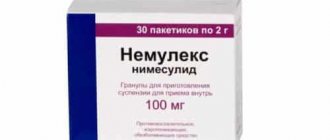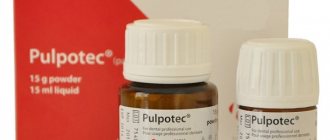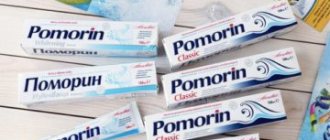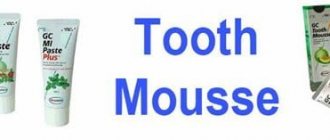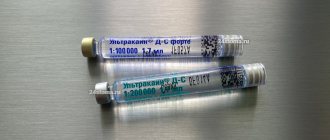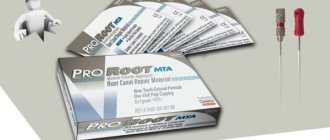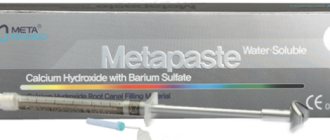What is a fissure of a tooth?
In Latin, fissure means “gap”. But this is a literal translation. In reality, fissures are more like grooves or grooves located among the cusps that make up the molar tooth. That is, they are of natural origin. However, these grooves change throughout life. At first they are shallow and have a smooth, flat bottom. Over time, the grooves between the sides of the tooth's cusps move downward, forming a deeper, inward-facing angle.
Thus, a fissure is a notch on the surface of a chewing tooth that cuts its enamel. This phenomenon can lead to caries. In such grooves, framed by the sharp edges of the tooth, food debris quickly accumulates, which can rot. Rotting causes the fissures to deepen.
Brushing your teeth will not help remove stains. Bacteria living in the oral cavity cope with plaque, but produce acid, which negatively affects the teeth and leads to the formation of caries.
Forms
Depending on the shape of the fissure, there are four types.
Funnel-shaped fissure
This form is the safest from the point of view of caries formation. After all, the type of funnel makes the furrow more open, and this does not allow the remaining food to get stuck. That is, food debris is washed out of the fissure on its own. In addition to the increased openness of the funnel-shaped form, its good mineralization can be noted as an advantage.
Cone-shaped fissure
This type of tooth cavity already creates conditions favorable for the accumulation of food debris. And the liquid collecting in the oral cavity directly affects the course of mineralization. However, careful control of the quality of brushing your teeth will help get rid of even the smallest food debris.
Drop-shaped or flask-shaped fissure
Its main characteristic is a very low level of cleanability. The structure of this groove is such that a toothbrush is not able to cope with the removal of all remaining pieces of food and other microorganisms. This situation is favorable for the development of caries.
Polypoid fissure
In many ways, it is similar to the drop-shaped form: the features of its structure lead to a slower mineralization process. This increases the risk of tooth decay.
Thus, the depth of the recess and the degree of complexity of its structure increase the risk of developing caries.
FISSURIT FX (VOCO) – fissure sealant – Instructions
Fissurit FX is a white, light-curing fissure sealant with fluoride and a high filler content (> 50%).
- Sealing/filling of fissures, pits, and small cavities
- Sealing/lining damaged enamel surfaces
- Strengthening orthodontic control systems and isolating areas at increased risk of developing caries during orthodontic treatment
- Sealing fillings made of composite or cement (protective layer against moisture)
Sealing of carious lesions to stop their progression.
Restoration of small defects in composite or amalgam fillings.
Sealing of baby teeth.
Fissurit FX - instructions:
Fissure sealing should be carried out as early as possible, provided that the occlusal surfaces have been completely erupted and good sealing can be guaranteed.
After insulation, clean the sealed surface, if possible mechanically (using a rotating brush and fluoride-free cleaning paste), rinse and dry.
In case of initial caries or unclear results after examination, open the fissure with a thin instrument.
Etching:
Apply Vococid etching gel with a disposable brush with short bristles (application control is carried out thanks to the blue color) and, depending on the condition of the enamel, leave to act for 15 - 30 s.
Rinse thoroughly and dry.
The etched enamel should appear opaque and matte white (prevent any subsequent contamination!).
Application of material from a syringe:
Remove the protective cap from the syringe. Screw a new cannula onto the syringe with Fissurit FX. Hold the syringe vertically and squeeze the material to the tip of the cannula to remove air bubbles. With light or moderate squeezing, Fissurit FX flows evenly from the cannula. If more force is required on the plunger to dislodge the material, check to see if the cannula is clogged.
Apply Fissurit FX, starting from the edge of the fissure or cavity, and allow time to flow into depth for 15 - 20 s. If necessary, remove any air bubbles that have arisen (for example, with a thin probe).
Important! After completing work, turn the piston slightly to relieve pressure to prevent any material from escaping unintentionally.
Polymerization:
Polymerize Fissurit FX (20 - 30 s for each surface) and check sealing. To photopolymerize the material, use standard polymerization devices. The luminous flux power should not be less than 500 mW/cm² for a halogen lamp and 300 mW/cm² for an LED lamp.
Seal the missing areas additionally, carefully remove excess material (for example, with a diamond finish) and, if necessary, polish the surface (with a rubber polisher). Finally, the treated and adjacent teeth, or even better, the entire dentition, are coated with fluoride varnish.
Storage:
After completing work with the material, remove the cannula from the syringe and close it with the protective cap. Each time you use the syringe, use a new application cannula. Fissurit FX should be stored at a temperature of 4°C - 23°C, protected from light. After the expiration date, Fissurit FX should no longer be used.
Directions and precautions
If the working surface is insulated insufficiently, there is a risk of premature (partial) loss of sealant.
In such cases, it is recommended to use fluoride varnish or seal the fissure with glass ionomer cement in order to wait until a perfect seal can be achieved.
If the etched surface becomes contaminated (eg with saliva), then adhesion may be significantly weakened. If contamination occurs, clean the surface, etch again for 10 - 20 s, rinse and dry.
Adhesion can be improved if bonding is used after etching (in difficult cases or when performing extended sealing).
Fissurit FX can only remain under the operating light for a short time, since otherwise its polymerization begins (viscosity increases). After work, check the periodontal sulcus and, if necessary, remove any remaining material.
Fissurit FX contains Bis-GMA, diurethane dimethacrylate, BHT, benzotriazole derivate, and sodium fluoride. Do not use the material in patients with allergies to these components . If possible, avoid contact with mucous membranes. Do not use cleaning and drying agents containing phenolic substances (for example, eugenol, thymol), as they prevent complete polymerization of the material.
Areas of carious lesions (for example, around fillings) can be stopped using sealants in cases where replacement of the filling is undesirable or impossible. To do this, clean the relevant areas, if possible, carry out minimal preparation and etching within the enamel. In such cases, complete sealing of the filling is recommended.
During orthodontic treatment, sealing sensitive areas for hygiene can provide reliable, long-lasting protection. In all cases, fluoridation measures should be continued to protect unsealed tooth surfaces from caries.
Delivery form:
- Syringes 2 x 2.5 g, application cannulas type 40
www.uadent.com
When should you resort to sealing?
The process of filling the grooves and grooves formed on the chewing teeth with a specialized product is called fissure sealing. The substance used during the procedure prevents the smallest microorganisms and pieces of food from entering the tooth grooves.
Essentially, the tooth is sealed and is inaccessible to the influence of harmful factors. The means by which sealing is carried out, as a rule, includes fluoride ions, and this makes the enamel resistant to the threat of caries.
The described procedure is performed for both adults and children. Both baby and molar teeth can be “sealed” with a special substance, since caries affects people of any age. However, in children the process of fissure mineralization is lower, so the possibility of enamel defects increases.
There are several indications for this procedure:
- the presence of teeth whose fissures have a complex structure and great depth, which leads to the accumulation of food debris in the grooves;
- the appearance of signs of caries;
- encountered when brushing teeth ;
- identification of pigmented fissures, that is, areas of enamel that are most susceptible to caries;
- the presence of teeth that are not yet four years old.
Indications for sealing are the appearance of weakly mineralized areas on the teeth, as well as the identification of areas susceptible to caries. A professional doctor, after checking the structure of the grooves, will immediately be able to determine the need for this procedure.
Why can our articles be trusted?
We make health information clear, accessible and relevant.
- All articles are checked by practicing doctors.
- We take scientific literature and the latest research as a basis.
- We publish detailed articles that answer all questions.
On the other hand, sealing will be contraindicated if the oral cavity is not well maintained. First, you will need to remove tartar and plaque and teach the patient how to properly care for their teeth. Also, the procedure cannot be carried out if the tooth openings are very wide and connected to each other. In this case, the sealing material may not be applied correctly.
Sealing methods
There are two main methods of sealing. The choice of one type of procedure or another is determined by the condition of the tooth surface.
Non-invasive fissure sealing
It is carried out when the patient has grooves that are unable to get rid of pieces of food and plaque using saliva and brushing the teeth. The non-invasive form does not involve surgical actions. A set of actions that the doctor will perform:
- cleans the tooth surface from the plaque layer;
- will work to make the edge of the tooth rough, as this is necessary for a stronger fixation of the sealant;
- apply sealant and secure it; the type of working material will determine how the operation to harden it will take place; in some cases special light is used.
It happens that the hollows on the chewing edge of the tooth are closed. This makes it difficult to clean them and then fill them with sealing material. In this case, the doctor will have to open the recesses using mechanical force.
Invasive fissure sealing
This method is used more often when the patient’s tooth enamel is almost completely formed and is approaching the final stage of formation. It was at this time that two circumstances converge at once: on the one hand, the enamel is not yet fully formed, on the other hand, plaque could already have accumulated in deep and closed fissures. The problem of getting rid of plaque will be solved by sealing by mechanically expanding the recesses.
The use of this method has an advantage over conventional filling, even if we are talking about caries that have already begun. A filling that is familiar to everyone, when applied to a tooth, covers at least ¼ of the chewing edge of the tooth. While the use of sealant reduces the coverage area by up to 5%.
To increase the width of the fissure and level its edges to the full depth, a diamond bur is used. Expansion and leveling are necessary to ensure that the sealant material properly fills the furrow cavity. In addition, this stage of sealing will help to detect those areas affected by caries that were not identified during a superficial examination.
When signs of caries are detected during the expansion of the fissure, the doctor must first take all measures to eliminate them. Only after removing the caries lesion can sealing begin.
When resorting to any of the described sealing methods, you need to understand that this operation is temporary. If the enamel of the chewing teeth is fully formed, then the presence of sealant no longer plays a big role, since the teeth have received the stability they are entitled to by nature and are now able to cope with some problems on their own. But this ability will only be preserved if you perform all hygiene procedures and periodically visit the dentist.
Fissurit/F/FX
FISSURIT/F/FH
(Fissurit/F/FX)
| Fissurite Bottle 3 ml x 2, white | 26.60€ |
| Fissurite F, white with fluorineidom Syringe 2 ml x 2, application cannulas type 40 | 21.20€ |
| Fissurit FX Syringe 2.5 g x 2, application cannulas type 40 | 30.00€ |
Instructions for use
Fissurit , a light-curing material for fissure sealing, is available in four varieties: transparent, white opaque,
Fissurit F - white, with fluoride content and Fissurit F X - white, with fluoride and a high filler content (> 50%).
Areas of use
— Sealing/filling of fissures, pits, and small cavities.
— Sealing/veneering of damaged enamel surfaces.
— Securing orthodontic adjusting structures and covering areas with an increased risk of developing caries during orthodontic treatment.
— Sealing fillings made of composite or cement (protective layer from moisture).
— Sealing of carious lesions to stop their development.
— Restoration of small defects in composite or amalgam fillings.
— Sealing of baby teeth.
Application
Fissure sealing should be carried out as early as possible, when the occlusal surfaces are fully erupted and work on a dry surface is guaranteed. After creating conditions for working without access to saliva, clean the surface to be sealed, if possible, mechanically (using a polishing brush and fluoride-free cleaning paste), rinse and dry. If caries begins or the condition of the fissure is unclear, open it with a thin instrument.
Etching
Apply gel (or liquid) for etching Vococid with a disposable brush with short bristles (application control is carried out thanks to the blue color) and leave to act for 15 - 30 s, depending on the condition of the enamel. Rinse thoroughly and dry. The etched enamel should be opaque and matte white (to avoid any subsequent contamination!). Please follow the instructions for use of Vococid .
Application of material
Carefully apply Fissurit / F / F X to the surface with a brush or other appropriate tool, distribute evenly and remove any possible air bubbles (probe).
Applying material from a syringe
Remove the protective cap from the syringe. Screw the new cannula onto the Fissurit / F / F X . Hold the syringe vertically and squeeze out the material to the tip of the cannula to remove air bubbles.
Fissurit / F / F X flows out of the cannula evenly with light or moderate pressure. If you need to press harder, check to see if the cannula is clogged.
Apply Fissurit / F / F X, starting from the edge of the fissure or cavity, and give time to spread over the surface (about 15 - 20 s). Remove possible air pores (for example, with a thin probe).
Important ! After completing the work, turn the piston slightly to relieve pressure and prevent any material from escaping unintentionally .
Light curing
Fissurit / F / F X (20 - 30 s on each surface) and check the sealing. For curing
light, use standard polymerization devices. The luminous flux power should not be less than 500 mW/cm² for a halogen lamp and 300 mW/cm² for an LED lamp. Seal the gaps additionally. Remove excess material (for example, with a diamond finish) and, if necessary, polish the surface (with a rubber polisher). Finally, coat the treated and adjacent teeth, or even better, all of them, with fluoride varnish.
Storage
After use, immediately close the Fissurit / F / F X Remove the cannula from the syringe. Each time you use the syringe, replace the application cannula with a new one. Fissurit / F / F X should be stored at a temperature of 4°C - 23°C in a place protected from light.
Fissurit / F / F X after the expiration date .
Indications and precautions
If it is impossible to achieve complete drying of the working surface, there is a danger of premature (partial) loss of tightness. In such cases, it is recommended to apply fluoride varnish or seal the fissures with glass ionomer cement and wait until a perfect seal can be achieved.
If the etched surface is contaminated (for example, with saliva), then the adhesion of the Fissurit / F / F X can be significantly weakened. In this case, clean the surface, etch again for 10 - 20 s, rinse and dry.
Adhesion can be enhanced if Solobond M (complicated cases or when performing extended sealing). To do this, apply Solobond M, distribute it over the surface with air, leave for 15–20 s to act and polymerize. Then apply Fissurit / F / F X.
Fissurit / F / F X can only be under the switched-on operating light for a short time, since this begins its polymerization (viscosity increases).
After work, check the periodontal sulcus and, if necessary, remove any remaining material.
Fissurit/F/FX contains BIS-GMA, diurethane dimethacrylate, BHT, benzotriazole derivative, and Fissurit F/FX additionally contains sodium fluoride. Do not use the material in patients with allergies to components. If possible, avoid contact with mucous membranes. Do not use cleaning and drying agents containing phenolic substances (for example, eugenol, thymol), as they prevent complete polymerization of the material.
Expansion of carious lesions (eg around fillings) can be prevented by appropriate sealing if replacement of the filling is undesirable or impossible. To do this, clean the surface to be treated, carry out minimal preparation and etching within the enamel. In this case, complete sealing of the filling is recommended.
During orthodontic treatment, sealing sensitive areas for hygiene can provide reliable, long-lasting protection.
In all cases, fluoridation measures should be carried out to protect unsealed tooth surfaces from caries.
Release forms
Fissurite
Additional packaging - 3 ml bottle x 2,
white Art. No. 1081
Additional packaging - 3 ml bottle x 2,
transparent Art. No. 1082
Fissurit F , white with fluoride and m
Syringe 2 ml x 2,
application cannulas type 40 Art. No. 1292
Additional packaging – bottle 3ml x 2 Art. No. 1180
Fissurit F X
Syringe 2.5 g x 2, application cannulas type 40 Art. No. 1181
Our preparations are developed for use in dentistry. Oral and/or written instructions, as well as our advice based on a detailed study of the material, do not oblige you to refuse to use the materials produced by us in accordance with your specialty and at your discretion. However, any use of our materials without our control is entirely your own responsibility. Of course, we guarantee that the quality of our materials complies with current standards, delivery and trading conditions comply with accepted standards.
www.ukrdentalshop.com.ua
